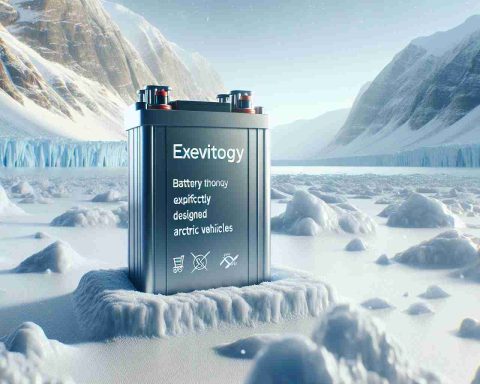- Innovative research in China reveals lithium titanium phosphate (LTP) as a game-changer for electric vehicle batteries in cold climates.
- LTP expands in cold temperatures, improving battery performance where traditional batteries struggle.
- Electron microscope studies show LTP’s cavity-rich crystal structure enhances ion movement.
- Efficiency remains at 84% in temperatures above 14°F, significantly improving electric vehicle range in winter.
- The addition of a carbon coating extends battery life to over 1,000 charge cycles.
- This technology has implications beyond transportation, aiding in efficient energy storage for wind and solar power.
- Breakthrough supports a resilient and sustainable future, promoting clean energy adoption.
Imagine a world where electric cars blaze through snowy landscapes without a hitch. In China, a team is unlocking this potential by battling the bane of cold weather: battery shrinkage. Instead of contracting, the savvy scientists discovered that lithium titanium phosphate (LTP) can actually expand in frigid temperatures, turning a common enemy into an ally.
These pioneers from Shanghai’s Donghua and Fudan Universities and Inner Mongolia University put LTP to the test with cutting-edge technology. High-tech electron microscopes revealed a crystal structure rich in cavities and channels, perfect havens for ions. As the mercury dives, these voids widen, keeping the ionic dance going strong, which is crucial for a battery’s health and lifespan.
In regions where winters bite hard, electric vehicles often witness a dramatic drop in range. At temperatures just above a frosty 14°F, this new tech ensures ion movement stays at an impressive 84% efficiency compared to solely warmer months. With a carbon coating, the results embrace even more promise, enduring 1,000 cycles of charge and discharge.
Why does this matter beyond our daily commutes? As renewable energy sources like wind and solar surge, storing energy reliably becomes crucial. Temperature-resilient batteries could be key in seizing the sun’s energy for those bleak days, contributing not only to individual ease but also fortifying the power grid against severe weather blackouts.
The journey is not solely scientific but driven by a deeper mission—durability and sustainability. This breakthrough signifies more than technological advancement; it underscores a step towards a greener, more resilient future. Embrace this innovation, for it’s not just about fighting the cold—it’s about heating up the global transition to clean energy.
Revolutionizing Electric Mobility: Powering Through the Cold with Lithium Titanium Phosphate
How LTP is Transforming Electric Vehicle Performance in Cold Weather
Electric vehicle (EV) batteries traditionally struggle in cold weather, leading to decreased range and efficiency. However, recent advancements using lithium titanium phosphate (LTP) are poised to change this narrative. Understanding why and how LTP works can provide valuable insights for consumers and industries alike.
How-To Steps & Life Hacks
To best leverage LTP technology for cold-weather driving:
1. Monitor Battery Health: Constantly check the battery management system for updates that may optimize LTP’s performance.
2. Precondition Your Battery: Before driving in subzero temperatures, preheat your vehicle while it is still plugged in to maintain battery efficiency.
3. Regular Maintenance Checks: Schedule periodic inspections to ensure the battery remains in optimal condition, especially after extreme weather conditions.
Real-World Use Cases
LTP batteries are not only beneficial for individual electric vehicles but also have broader applications:
– Battery Storage for Solar Energy: In areas where temperature fluctuations challenge energy storage, LTP’s stable performance in cold weather can enable better home and industrial solar energy storage solutions.
– Public Transport: Cities with harsh winters can deploy buses or trams powered by LTP batteries, ensuring reliable public transport in all seasons.
Market Forecasts & Industry Trends
The global demand for cold-resistant battery technology, including LTP, is on the rise. According to a report by MarketWatch:
– The global automotive battery market is estimated to reach USD 95 billion by 2026, with a significant share attributed to innovations in cold-resistant technologies.
– EV manufacturers in cold-climate countries like Canada, Norway, and Russia are integrating these technologies to meet consumer needs.
Reviews & Comparisons
When comparing LTP to traditional lithium-ion batteries:
– Pros of LTP:
– Better performance in cold temperatures
– Longer lifespan due to enhanced cycle stability
– Eco-friendlier due to reduced resource strain
– Cons of LTP:
– Currently more expensive to produce
– Still in the research phase, limiting availability
Security & Sustainability
LTP batteries offer a more sustainable option thanks to their longer lifespan and their efficiency in storing renewable energy. They are also potentially safer due to their stable crystal structure, which reduces the risk of thermal runaway.
Insights & Predictions
Experts predict that the integration of LTP technology will lead to a significant shift in the EV industry:
– Electric vehicle adoption in colder regions is expected to increase, overcoming one of the main barriers—temperature sensitivity.
– Further developments could lower production costs of LTP batteries, making them more widely available and affordable.
Actionable Recommendations
1. Invest in Vehicles with LTP Technology: Consumers living in colder climates should consider vehicles equipped with LTP batteries for better winter performance.
2. Explore Renewable Energy Storage Solutions: Homeowners can investigate battery storage systems equipped with LTP for improved energy management during winter months.
3. Stay Informed on Developments: Keep an eye on advancements from leading universities and technology companies, as improvements in LTP efficiency and cost are on the horizon.
For further information and updates on electric vehicle technology, visit Tesla or BMW.








